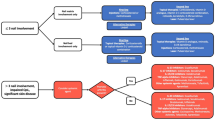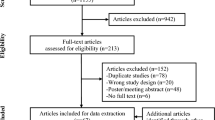Abstract
Nail psoriasis affects up to 90% of patients with psoriasis in their lifetime and is seen in 80% of patients with psoriatic arthritis. These changes of nail psoriasis often cause significant pain, psychological effects, and result in restrictions of daily activities. In patients with nail psoriasis, the choice of effective therapy is limited and depends on various factors, including the severity of the disease, the ability of patients to tolerate treatment, and their ability to pay (insurance) for what are, in some cases, expensive treatments. In recent years, biological therapies have proved effective in improving nail psoriasis, have generally proved to be well tolerated and require minimal patient monitoring. In the right situation, therefore, the use of biological agents is justified in patients with psoriatic nail disease.



Similar content being viewed by others
References
Lawry M. Biological therapy and nail psoriasis. Dermatol Ther 2007; 20: 60–7
de Berker D. Management of nail psoriasis. Clin Exp Dermatol 2000; 25: 357–62
Nickoloff BJ, Nestle FO. Recent insights into the immunopathogenesis of psoriasis provide new therapeutic opportunities. J Clin Invest 2004; 113: 1664–75
Gottlieb AB. Psoriasis: emerging therapeutic strategies. Nat Rev Drug Discov 2005; 4: 19–34
Grammer-West NY, Corvette DM, Giandoni MB, et al. Clinical pearl: nail plate biopsy for the diagnosis of psoriatic nails. J Am Acad Dermatol 1998; 38: 260–2
Rich P, Scher RK. Nail Psoriasis Severity Index: a useful tool for evaluation of nail psoriasis. J Am Acad Dermatol 2003; 49: 206–12
Cassell SE, Bieber JD, Rich P, et al. The modified Nail Psoriasis Severity Index: validation of an instrument to assess psoriatic nail involvement in patients with psoriatic arthritis. J Rheumatol 2007; 34: 123–9
Sterry W, Barker J, Boehncke WH, et al. Biological therapies in the systemic management of psoriasis: International Consensus Conference. Br J Dermatol 2004; 151 Suppl. 69: 3–17
Reich K, Nestle FO, Papp K, et al. Infliximab induction and maintenance therapy for moderate-to-severe psoriasis: a phase III, multicentre, doubleblind trial. Lancet 2005; 366: 1367–74
Rich P, Griffiths CE, Reich K, et al. Baseline nail disease in patients with moderate to severe psoriasis and response to treatment with infliximab during 1 year. J Am Acad Dermatol 2008; 58: 224–31
van den Bosch F, Reece R, Behrens F, et al. Clinically important nail psoriasis improvements are achieved with adalimumab (Humira®): results from a large open-label prospective study (STEREO). Ann Rheum Dis 2007; 66 Suppl. II: 421 (Abstract FRI0472)
Lamerson C, Stevens G, Sax K. Treatment of nail psoriasis with efalizumab: a preliminary study. Cutis 2008; 82: 217–20
Food and Drug Administration. Raptiva (efalizumab) Feb 2009. 2009 [cited 2009 July 21]; Available from: http://www.fda.gov/Safety/MedWatch/SafetyInformation/SafetyAlertsforHumanMedicalProducts/ucm149675.htm
Parrish CA, Sobera JO, Robbins CM, et al. Alefacept in the treatment of psoriatic nail disease: a proof of concept study. J Drugs Dermatol 2006; 5: 339–40
Korver JE, Langewouters AM, Van De Kerkhof PC, et al. Therapeutic effects of a 12-week course of alefacept on nail psoriasis. J Eur Acad Dermatol Venereol 2006; 20: 1252–5
Rich P, Gupta A. Etanercept improves nail psoriasis. J Am Acad Dermatol 2005; 52 (3 Suppl 1): P184 (Abstract P2751)
Acknowledgments
Editorial assistance for the preparation of this manuscript was provided by Stephanie Blick of inScience Communications. This assistance was funded by Pfizer. Dr Zaiac reports no conflicts of interest.
Author information
Authors and Affiliations
Rights and permissions
About this article
Cite this article
Zaiac, M. The Role of Biological Agents in the Treatment of Nail Psoriasis. AM J Clin Dermatol 11 (Suppl 1), 27–29 (2010). https://doi.org/10.2165/1153418-S0-000000000-00000
Published:
Issue Date:
DOI: https://doi.org/10.2165/1153418-S0-000000000-00000




